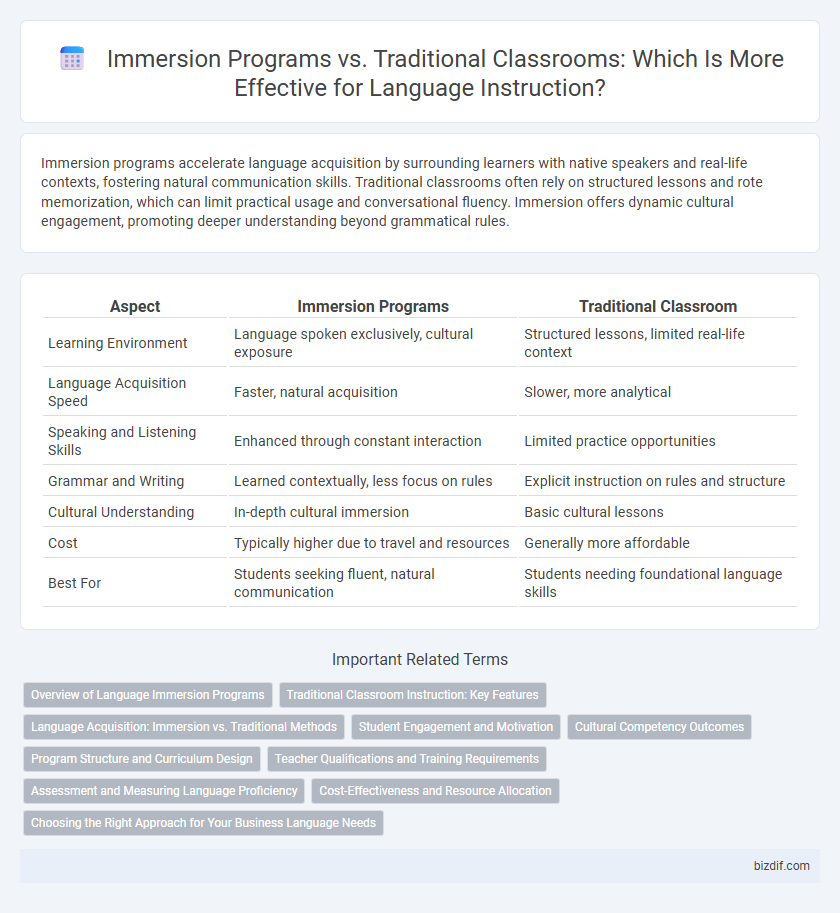Immersion programs accelerate language acquisition by surrounding learners with native speakers and real-life contexts, fostering natural communication skills. Traditional classrooms often rely on structured lessons and rote memorization, which can limit practical usage and conversational fluency. Immersion offers dynamic cultural engagement, promoting deeper understanding beyond grammatical rules.
Table of Comparison
| Aspect | Immersion Programs | Traditional Classroom |
|---|---|---|
| Learning Environment | Language spoken exclusively, cultural exposure | Structured lessons, limited real-life context |
| Language Acquisition Speed | Faster, natural acquisition | Slower, more analytical |
| Speaking and Listening Skills | Enhanced through constant interaction | Limited practice opportunities |
| Grammar and Writing | Learned contextually, less focus on rules | Explicit instruction on rules and structure |
| Cultural Understanding | In-depth cultural immersion | Basic cultural lessons |
| Cost | Typically higher due to travel and resources | Generally more affordable |
| Best For | Students seeking fluent, natural communication | Students needing foundational language skills |
Overview of Language Immersion Programs
Language immersion programs immerse learners in a target language through consistent, contextual use across subjects, accelerating fluency and cultural understanding. These programs emphasize practical communication skills by integrating language with daily activities, contrasting with traditional classrooms that often rely on rote memorization and grammar drills. Immersion fosters natural language acquisition and cognitive benefits by simulating real-life language environments and encouraging active engagement.
Traditional Classroom Instruction: Key Features
Traditional classroom instruction emphasizes structured lesson plans, teacher-led explanations, and a consistent learning environment designed to reinforce language fundamentals. It incorporates systematic grammar drills, vocabulary exercises, and standardized assessments to track progress. This method benefits learners who thrive on clear guidance, immediate feedback, and a familiar classroom routine.
Language Acquisition: Immersion vs. Traditional Methods
Immersion programs accelerate language acquisition by surrounding learners with the target language in authentic contexts, fostering natural communication and cultural understanding. Traditional classroom methods often emphasize grammar rules and vocabulary drills, which may limit practical language usage and fluency. Research indicates that immersion leads to higher proficiency and better long-term retention compared to conventional language instruction.
Student Engagement and Motivation
Immersion programs significantly enhance student engagement by providing a dynamic, context-rich environment that mirrors real-life language use, fostering intrinsic motivation through authentic communication opportunities. Unlike traditional classrooms, immersion promotes consistent exposure and interactive practice, which accelerates language acquisition and sustains learner interest. Research indicates students in immersion settings exhibit higher motivation levels and greater linguistic confidence, leading to improved proficiency outcomes.
Cultural Competency Outcomes
Immersion programs significantly enhance cultural competency by exposing learners to authentic language use and cultural contexts, fostering deeper understanding and empathy. Traditional classroom settings often emphasize grammar and vocabulary without providing sufficient real-world cultural interactions, limiting practical cultural awareness. Studies show immersion participants demonstrate higher proficiency in cultural norms, communication styles, and intercultural sensitivity compared to traditional learners.
Program Structure and Curriculum Design
Immersion programs employ a curriculum that integrates language learning with content instruction, promoting natural language acquisition through real-life contexts and cultural exposure. Traditional classroom settings typically separate language instruction from subject matter, relying heavily on grammar drills and rote memorization. Program structure in immersion prioritizes continuous, contextualized language use, while traditional classrooms follow segmented lessons with periodic assessments focused on language rules.
Teacher Qualifications and Training Requirements
Immersion programs require teachers to possess advanced bilingual proficiency and specialized training in immersive language instruction methods, ensuring authentic language exposure and cultural context. Traditional classroom settings typically demand certification in language teaching and foundational pedagogical training, focusing on structured grammar and vocabulary lessons. The heightened qualifications in immersion settings lead to more effective language acquisition through experiential learning and continuous linguistic interaction.
Assessment and Measuring Language Proficiency
Immersion programs utilize continuous, context-rich assessments that measure language proficiency through practical communication tasks, whereas traditional classrooms often rely on standardized tests and written exams. Immersion assessments capture real-time language use and fluency, providing a comprehensive understanding of learners' speaking, listening, reading, and writing skills. Traditional methods focus more on grammatical accuracy and vocabulary knowledge, potentially overlooking conversational competence and cultural nuances.
Cost-Effectiveness and Resource Allocation
Immersion programs often demonstrate higher cost-effectiveness by combining language acquisition with cultural exposure, reducing the need for supplementary materials and extended instructional hours common in traditional classrooms. Resource allocation in immersion settings prioritizes immersive environments and native speaker instructors, streamlining expenditures compared to traditional models that require separate language classes and diverse curricula. This efficient use of resources not only enhances language proficiency but also maximizes institutional budgets.
Choosing the Right Approach for Your Business Language Needs
Immersion programs accelerate language acquisition by surrounding learners with the target language in real-world contexts, enhancing fluency and cultural understanding critical for business communication. Traditional classroom instruction offers structured learning with a focus on grammar, vocabulary, and business-specific terminology, suitable for foundational knowledge and flexible scheduling. Selecting the right approach depends on your company's goals, timeline, and the desired level of proficiency for effective cross-cultural business interactions.
Immersion programs vs traditional classroom Infographic

 bizdif.com
bizdif.com